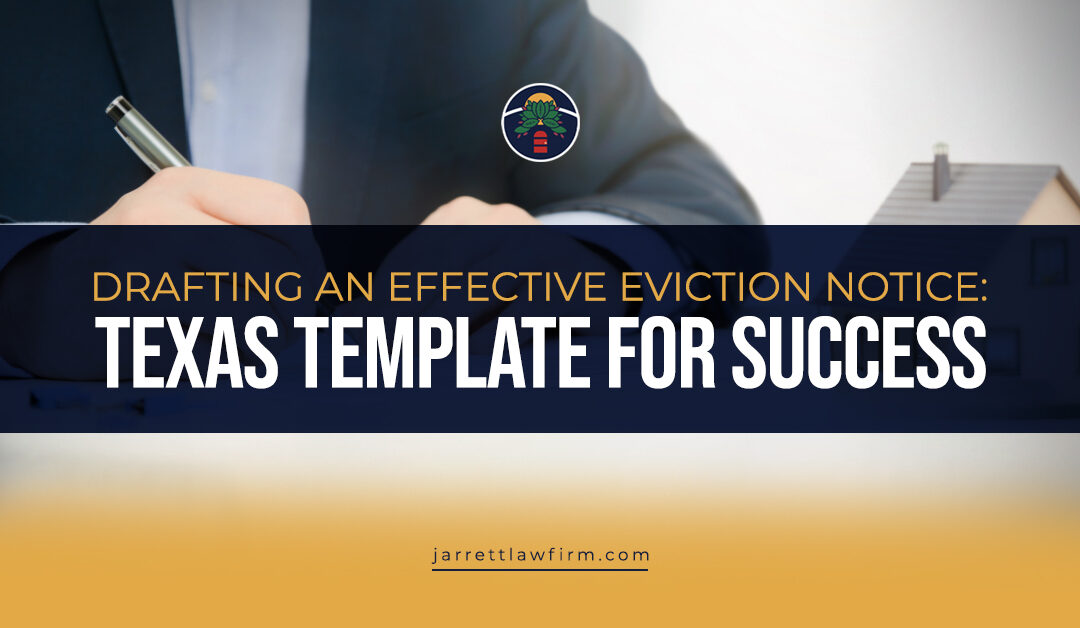If you’re a landlord in Texas for long enough, you’ll most likely eventually need to create an eviction notice. Think of it as your first step on the path to reclaiming your property, but it’s packed with legal landmines that can trip you up if you’re not careful. In our guide “Drafting an Effective Eviction Notice: Texas Template For Success”, we’ll show how this isn’t just any old letter.
It’s a legal document deeply rooted in Texas property law, and getting it right can save you a world of headaches down the line.
Now, you might be wondering, “Where do I even start?” The answer is right here. Whether you’re drafting your first eviction notice or looking to refine your approach, we’re going to walk through this together, step by step. We’ll share everything you need to know about creating an eviction notice that’s not only effective but also fully compliant with Texas law.
So, grab a cup of coffee, and let’s make this process as smooth as possible for you. After all, the goal here is to make sure your eviction notice is your ally, not your adversary.
Understanding Texas Eviction Laws
Alright, let’s roll up our sleeves and get down to the nitty-gritty of Texas eviction laws. If you’ve found yourself in a position where you need to evict a tenant, it’s crucial to start on solid ground, legally speaking.
Texas doesn’t mess around when it comes to property laws, and neither should we.
Valid Reasons
First off, you need a valid reason to evict someone. It’s not as simple as not liking the color they painted the living room (even if it’s a truly horrible shade).
We’re talking about serious stuff like not paying rent, violating the lease in some major way, or causing significant damage to the property. Texas law is clear on this: you need a solid reason that stands up in court.
Before Sending the Eviction Notice
Now, before you even think about sending that eviction notice, Texas law requires you to give your tenant a heads-up. This isn’t a “nice to do”; it’s a “must-do.” You’ve got to tell them what they did wrong and give them a chance to fix it (if it’s fixable). Miss this step, and you could be back to square one, with your tenant still comfortably living in your property.
What’s a Notice Period?
And here’s where it gets a bit more technical. The notice period – that’s how long your tenant has to either remedy the situation or pack up and leave.
Generally, it’s three days, but check your lease agreement; it might specify a different timeframe. This notice period is your tenant’s last chance to make things right or move on, and it’s legally required.
Skipping this step is like trying to run before you can walk – you’re just going to trip up.
In a nutshell, Texas eviction laws are all about following a specific process.
You’ve got to have a valid reason, give proper notice, and respect the legal timelines. It’s like baking a cake; miss one ingredient, and the whole thing falls flat.
So, let’s make sure we get this recipe right, ensuring a smooth and legally sound eviction process, should you need to go down that path.
Eviction Notice: Texas Template
This example is for informational purposes only and not for the purpose of providing legal advice. Talk with an experienced eviction lawyer to obtain advice with respect to any particular issue or problem or to answer any specific legal questions you may have.
Here’s an example of a Texas eviction notice letter:
[Your Name or the Property Management Company’s Name]
[Your Address]
[City, State, ZIP Code]
[Phone Number]
[Email Address]
[Date]
[Tenant’s Name]
[Rental Property Address]
[City, State, ZIP Code]
Re: Notice to Vacate
Dear [Tenant’s Name],
This letter serves as official notice for you to vacate the premises located at [Rental Property Address], pursuant to the Texas Property Code §24.005.
Reason for Eviction Notice:
[Clearly state the reason for the eviction notice, such as non-payment of rent, lease violation, etc. Be specific about the violation or issue, including dates and relevant details.]
Notice Period:
You are hereby given [3 days, 30 days, or other period as specified in the lease agreement] notice to vacate the premises on or before [Date], which is at least three days from the delivery of this notice as required by Texas law for [specify reason such as non-payment of rent, lease violation, etc.].
Action Required:
[Specify any action the tenant can take to remedy the violation, if applicable, and the deadline for doing so. For example, “You must pay the full past due rent amount of $[Amount] by [Date] to avoid eviction.”]
If you fail to [remedy the violation/pay the past due rent] or vacate the premises by [Date], legal action may be initiated to enforce eviction. This could result in you being required to pay court costs and attorney fees in addition to any past-due rent or damages.
Please understand that this notice is served in accordance with the Texas Property Code and does not waive the right to collect any fees, rent, or charges that are due under the terms of your lease agreement.
Delivery Method:
[Specify how the notice was delivered, in accordance with Texas law requirements, such as “This notice has been sent via certified mail, return receipt requested, and posted on the main entry door of the premises.”]
We recommend you seek legal advice to fully understand your rights and obligations. If you have any questions regarding this notice or your tenancy, please contact me directly at [Phone Number] or [Email Address].
Sincerely,
[Your Signature]
[Printed Name]
[Title/Position, if applicable]
Components of an Effective Eviction Notice in Texas
When it comes to crafting an eviction notice in Texas, think of it as putting together that cake recipe we mentioned above. You need the right ingredients, measured precisely, and mixed in the correct order.
Miss a step or forget an ingredient, and your cake (or, in this case, your eviction notice) won’t turn out well. Let’s make sure we get this recipe right.
First, let’s talk about the “ingredients” of your eviction notice. You’re going to need a few key pieces of information to make it legally valid:
- Tenant’s name and rental property address: This is like setting the table before a meal. Make sure you’ve got the right location and the tenant’s name as it appears on the lease.
- Reason for eviction: Whether it’s non-payment of rent, lease violation, or another serious issue, be clear and concise. Texas eviction laws are strict about having a solid reason for eviction.
- Notice period: Typically, this is a three-day notice to quit for non-payment of rent or other lease violations, but it can vary depending on your lease agreement. This is the “cooking time” for your notice.
- Remedy or vacate instructions: If the tenant can fix the issue (like paying past due rent), tell them how and by when. If the situation isn’t fixable, they need to vacate the premises.
- Date and landlord’s signature: Seal the deal with your signature and the date. This officially marks the start of the eviction process.
Serving Your Texas Eviction Notice (Not on a Platter)
Now, onto the “cooking method” – serving the notice. Texas property code is particular about how you deliver this notice to your tenant:
- In-person: Hand it directly to the tenant or an adult living in the home.
- Certified mail and return receipt requested: This gives you a record that the tenant received the notice.
- Posting on the main entry door: If you can’t reach the tenant in person or by mail, you can post the notice on the door. Just be aware that if you use this method, also send a mail copy in case it’s your word against theirs that you posted the notice to quit.
After serving the notice, if the tenant fails to pay rent or rectify the lease violation within the given time period, you can move on to filing an eviction suit in your local Texas justice courts. Remember, the eviction notice is just the appetizer in the eviction process feast.
If the tenant doesn’t comply, you’ll need to prepare for the main course – the eviction lawsuit, which includes filing fees, possibly hiring a professional process server, and preparing for a court hearing.
Keep in mind, each step, from the eviction notice to the court order for eviction, needs careful attention to detail. Whether it’s ensuring the notice form reaches the other party through registered mail or presenting your case in justice court, you want to make sure everything is done by the book.
Texas law doesn’t take kindly to skipped steps or incomplete paperwork, especially when it comes to something as serious as evicting a tenant.
In summary, crafting an effective eviction notice in Texas is about precision, clarity, and following the legal recipe to the letter. From choosing the right eviction notice form to understanding the nuances of Texas eviction notices, every detail matters.
Whether it’s a month-to-month tenancy or a more extended lease agreement, handling eviction notices with care can ensure a smoother process for both the landlord and the tenant.
After Serving the Eviction Notice: Next Steps
So, you’ve served the eviction notice following all the rules to a T. Now, you might be wondering, “What’s next?”
Well, if the tenant hasn’t paid the overdue rent or fixed the lease violations after receiving the notice, it’s time to officially start the eviction process. Let’s walk through these steps together, making sure we’re still on the right path.
Filing the Forcible Entry and Detainer Suit
First up, if the tenant hasn’t responded to your eviction notice by either rectifying their lease violations or vacating the premises, you’ll need to file an eviction suit, often referred to as a “forcible entry and detainer” suit, at your local justice court. Think of this as moving from a polite knock on the door to ringing the doorbell loudly – it’s your formal way of saying, “It’s time to resolve this issue.”
Filing this eviction suit means you’re bringing your case to the court’s attention. Here’s what you’ll need to include:
- A detailed petition: This document lays out your reasons for eviction, backed by Texas eviction laws. Whether it’s unpaid rent or another lease violation, make your case clear.
- The eviction notice: Remember that eviction notice you meticulously filled out? Attach a copy of it, along with proof of how it was served to the tenant (certified mail receipt, for instance).
- Filing fee: Yes, there’s a cost to file an eviction suit, but consider it an investment towards regaining control of your property.
After you’ve filed your petition, the court will set a hearing date. This is your opportunity to present your case in front of a judge, typically a justice of the peace in Texas.
This hearing is crucial – it’s where you’ll need to prove that you’ve followed all the proper steps in the eviction process, from serving the eviction notice correctly to filing the eviction suit on time.
The Court Hearing
Now, let’s talk about the court hearing. Here are a few tips to prepare:
- Documentation: Bring all relevant documents, including the lease agreement, the eviction notice you served, any communication with the tenant, and records of rent payments (or lack thereof).
- Witnesses: If anyone can support your case (like a property manager or neighbors who witnessed lease violations), bring them along.
- Professional demeanor: Courtrooms demand respect. Dress appropriately and be polite, no matter how frustrated you might be with the situation.
- Professional Help: An experienced attorney can make all the difference in pleading your case against the tenant.
If the court rules in your favor, you’ll receive a court order for eviction, known as a writ of possession. This document authorizes law enforcement to remove the tenant from your property if they haven’t vacated voluntarily within the grace period typically given after the hearing.
Navigating the post-eviction notice landscape can feel daunting, but remember, Texas law has laid out a clear path for this process. By understanding each step, from filing the eviction suit to presenting your case in court, you’re well on your way to resolving the situation.
Keep focused, stay informed, and soon you’ll have your property back and be ready to move forward.
Jarrett Law Can Help
At Jarrett Law, in Houston, TX, we understand that navigating the eviction process can be overwhelming for landlords. With Texas property laws being as intricate as they are, having a trusted ally by your side can make all the difference. That’s where we come in.
Our team specializes in landlord-tenant disputes and the eviction process, ensuring you’re not just another landlord left trying to figure it out on your own.
Personalized, Comprehensive Support for Landlords
We pride ourselves on offering personalized, comprehensive legal support tailored to your unique situation. Whether you need assistance drafting a legally sound eviction notice, navigating the justice court system, or representing you at a court hearing, Jarrett Law is here to help.
Our expertise in Texas eviction laws means we’re equipped to guide you through each step of the process, from serving the initial notice to vacate right through to obtaining a writ of possession, should it come to that.
Providing You Peace of Mind
What sets us apart? Our commitment to our clients. We understand the stress and financial strain that problematic tenancies can cause. That’s why we aim to provide not just legal assistance, but peace of mind.
Our team will handle the legal legwork, ensuring all documentation is in order, representing you in court, and advising you on the best course of action, so you can focus on what matters most – managing your property effectively.
Let Us Lighten Your Load
Don’t let the complexities of the eviction process weigh you down. Let Jarrett Law lighten the load. Contact us today to learn more about how we can assist you with your eviction needs in Houston, TX. Together, we’ll ensure your property is back in your hands as swiftly and smoothly as possible.



Recent Comments